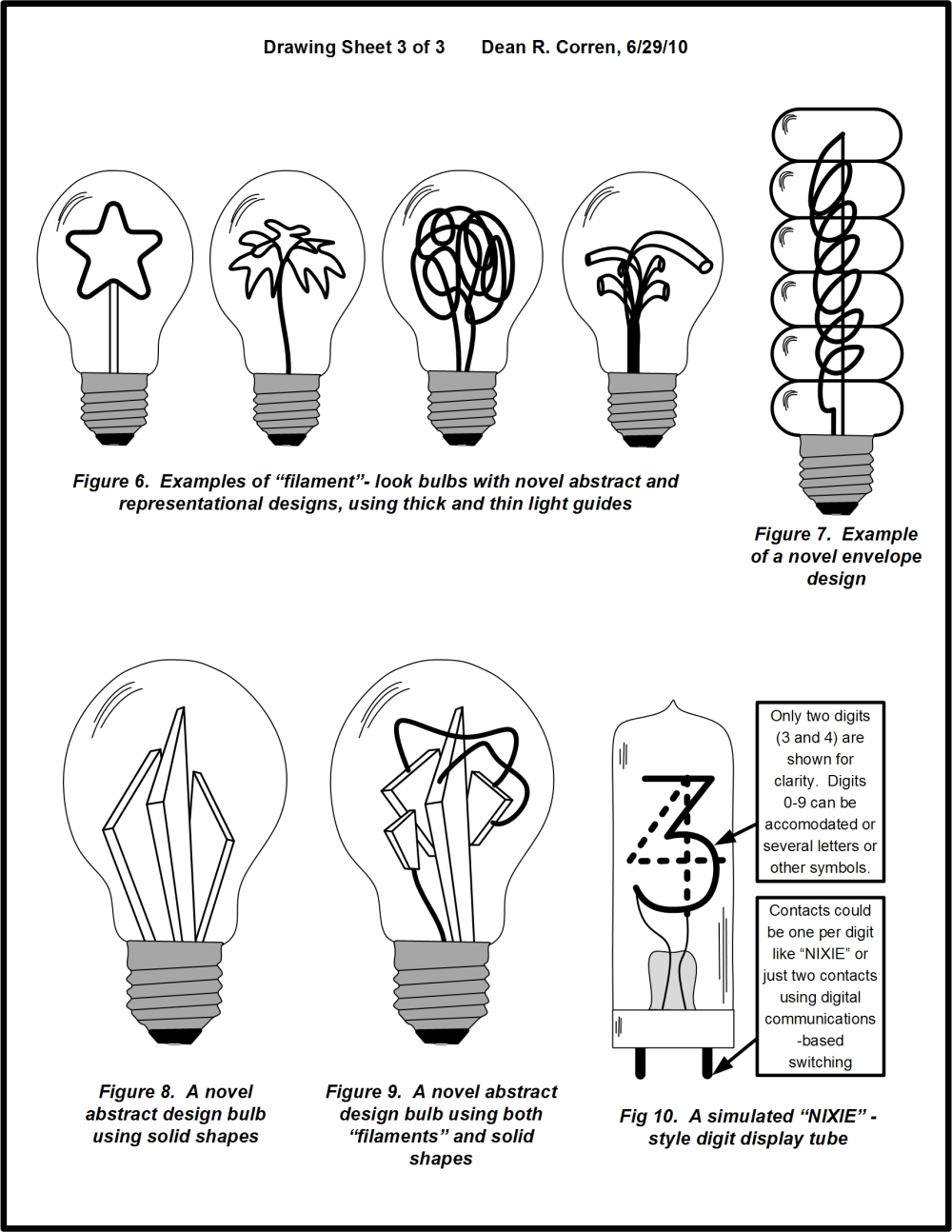Modern high-efficiency light bulbs such as compact fluorescents and Light Emitting Diode (LED) bulbs look very different from conventional, vintage, or antique incandescents. However, sometimes, the appearance of an incandescent bulb, with its glowing filament is highly desirable. Reproduction incandescent bulbs are still made and have a growing market (NYTimes, 6/7/10 ) despite consuming electricity extremely inefficiently, and contrary to bans being implemented and considered in many countries.
This invention is a means to make highly efficient, long life bulbs that can have the look of any vintage filament-type bulb, along with entirely novel light emitting shapes and colors.
This new bulb contains of one or more LEDs directing light through one or more light guides of plastic or glass fibers, bundles of fibers, or solid shapes. Light passing through such “filaments” can be emitted from the light guide material by abrasion or etching. This can simulate the appearance of the glowing filament(s) of an incandescent bulb.
The advantages of this separation of the source and emission functions include: high efficiency, long life, and wide design, color, and control flexibility. It can use the attributes of the LED (small size, low power, low heat) to exploit and extend its benefits.
Beyond reproducing a vintage look, the light guides can create entirely novel shapes, including text or symbols, with various emission patterns. Solid shapes of plastic or glass can emit light in any shape, such as the traditional "flame”shape.
Since the light-emitting elements are cool, the bulb envelope does not need evacuation and sealing, and the “filaments” can cross each other, allowing great design flexibility and production cost reduction. The envelope can be glass or plastic which is clear, frosted, textured, or colored, and in any standard shape, such as torpedo, tube, candelabra, and novel shapes. Without sealing, the envelope is easily replaceable for repair or color change, while the rugged, long-life, (and more expensive) electronics and light section is reused.
The light guide fibers can be thick or thin, self-supporting or supported by glass, plastic or metal elements. Various LED colors and filters can provide any color or multiple colors. A standard base and voltage can be used or a novel base for OEM use at any voltage, AC or DC. The light design within the bulb can be 3-Dimensional, or 2-Dimensional, such as a symbol or logo, in which case a bayonet-type base or a swiveling screw base fixture may assist bulb orientation.
Multiple “filaments” can have electronically time-switched light sources, allowing a motion effect such as a flickering flame. The old “NIXIE" type numeric digit display tube can be simulated. By including a communications signal-receiving device, the different “filaments” can be switched under external control without multiple external contacts.
Because the reproduction incandescent bulbs are themselves very expensive (~$10-20, twice some LED bulbs), starting production for this market can be quickly competitive. Then, beyond vintage-look bulbs, this approach can create a vast new market for efficient bulbs using unprecedented design flexibility for both functionality and appearance.
Like this entry?
-
About the Entrant
- Name:Dean Corren
- Type of entry:individual
- Hardware used for this entry:LenovoSoftware used for this entry:MS-Visio, MS-Word, Irfanview, MS-IE
- Patent status:pending








